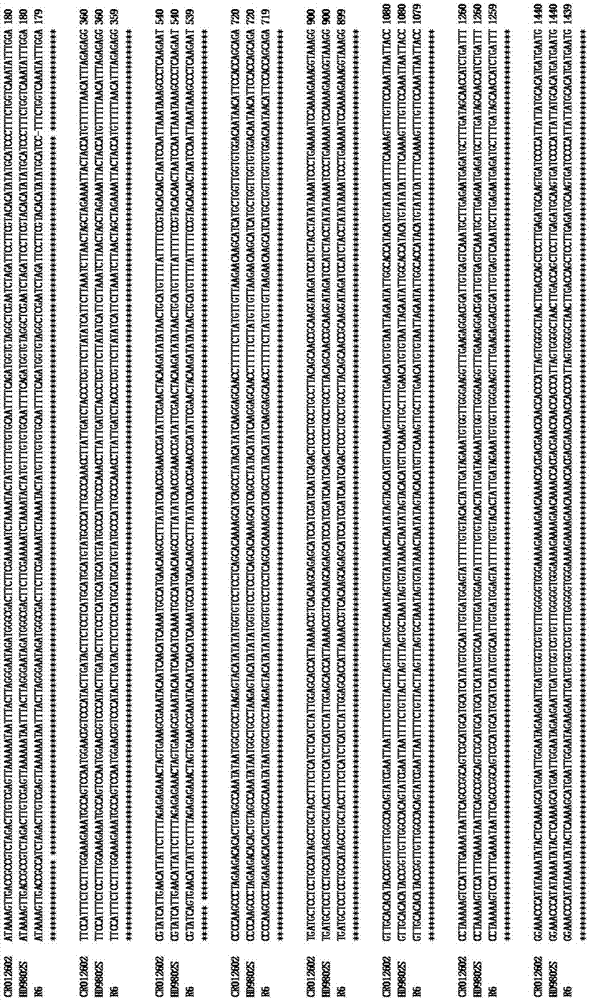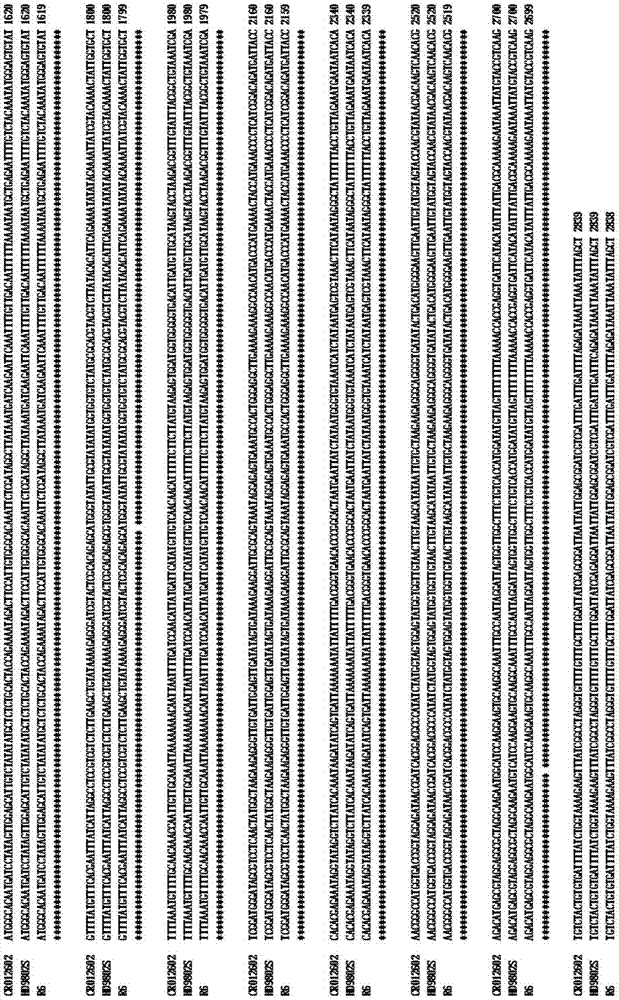Recombinant nucleic acid fragment RecCR012602 and detection method thereof
A technology for recombining nucleic acid and fragments, applied in the field of recombining nucleic acid fragments and their detection, can solve the problems of time-consuming and low efficiency
- Summary
- Abstract
- Description
- Claims
- Application Information
AI Technical Summary
Problems solved by technology
Method used
Image
Examples
Embodiment 1
[0040] Example 1 Breeding of Recombinant Plants Introduced with Blast Resistance Genome Fragment
[0041] The materials used in this example are rice 'HD9802S' and rice 'R6'.
[0042] Rice 'R6' has good blast resistance, and it is speculated that the gene cluster region where Pi2, Pi9 and Pigm of chromosome 6 are located may play a key role in the rice blast resistance of this material.
[0043] During the breeding process of the recombinant plants, the molecular markers were used to perform prospect selection on the recombinant plants, and the adopted molecular markers for prospect selection were screened. Referring to the rice Nipponbare genome MSU / TIGR annotation version 6.1, download the DNA sequence of chromosome 6 from 9,559,000 to 10,990,000. The SSR sites in the above sequences were scanned using SSRLocator software. Primer Premier 3.0 software was used to design primers for the found SSR loci, and a total of 162 pairs of primers were designed. Through the PCR met...
Embodiment 2
[0054] Example 2 Determination of Homologous Recombination Fragments After Introducing Blast Resistance Genome Fragments
[0055] In order to determine the size of the imported rice blast resistance genome fragment, the homozygous individual plants of the 'HD9802S' imported fragment were sequenced for homologous recombination fragments on both sides of the target genome fragment. The recombinant nucleic acid fragment of the rice blast resistance genome contained in CR012602 was named RecCR012602.
[0056] It was preliminarily determined by the rice genome-wide breeding chip RICE60K detection results that RecCR012602 was located between two SNP markers R0610084130TG and R0610454932GA.
[0057] At the same time, three samples of 'HD9802S', 'R6' and CR012602 were sequenced whole-genome using Miseq sequencing technology. The TruSeq Nano DNA LT Kit (illumina) kit was used for library establishment, the Library Quantification Kit–Universal (KAPA Biosystems) kit was used for quant...
Embodiment 3
[0068] Example 3 Resistance Identification of Rice Blast Resistance Genomic Fragment Imported into 'HD9802S'
[0069] In order to identify the resistance effect, the new line CR012602 selected by the application, the recurrent parent 'HD9802S', the rice blast disease-resistant variety Gumei No. 4 (as a positive control), and the rice blast disease-susceptible variety Lijiang Xintuan Heigu (as a negative control) Control) is carried out indoor planting, and adopts following method to identify after it is cultivated to the 3-4 leaf stage:
[0070] Select M15Bb-1-1, M15Bb-1-2, M15Bb-2-1, M15Bb-3-1, M15Bb-4-1, M15Bb-5-1 isolated from rice blast disease samples in Yichang disease nursery, Hubei in 2015 and M15Bb-6-1, a total of 7 blast strains were used as inoculation strains. The strain was stored at -20°C by the sorghum grain method. Before use, the preserved sorghum grains were taken out and activated on a potato dextrose medium (PDA) plate (PDA: 200g peeled potatoes, 20g glu...
PUM
 Login to View More
Login to View More Abstract
Description
Claims
Application Information
 Login to View More
Login to View More - R&D
- Intellectual Property
- Life Sciences
- Materials
- Tech Scout
- Unparalleled Data Quality
- Higher Quality Content
- 60% Fewer Hallucinations
Browse by: Latest US Patents, China's latest patents, Technical Efficacy Thesaurus, Application Domain, Technology Topic, Popular Technical Reports.
© 2025 PatSnap. All rights reserved.Legal|Privacy policy|Modern Slavery Act Transparency Statement|Sitemap|About US| Contact US: help@patsnap.com



